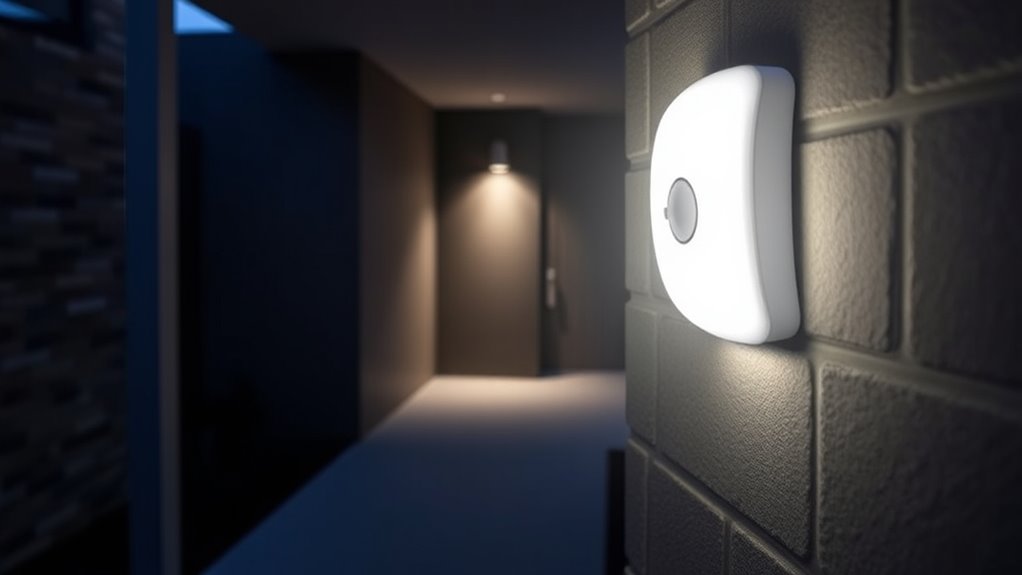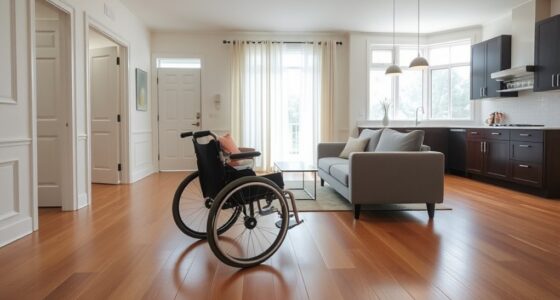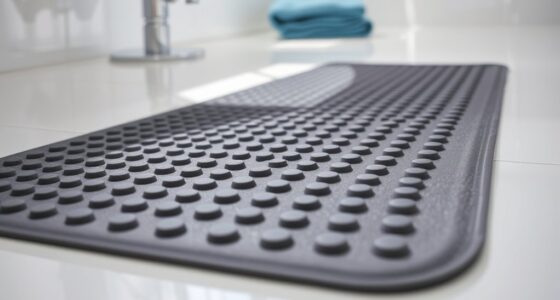Adding motion-sensor lights is a simple way to improve your home’s safety, energy efficiency, and convenience. These lights turn on automatically when they detect movement, helping you see clearly in dark areas without fumbling for switches. They also deter intruders and prevent accidents by illuminating walkways and entry points. With adjustable settings for sensitivity and duration, you can customize them to suit your needs. Keep going—there’s more to know about making the most of these smart lighting options.
Key Takeaways
- Choose suitable locations like entryways, pathways, or garages for optimal coverage.
- Follow manufacturer instructions for easy installation and secure mounting.
- Adjust sensitivity, duration, and light levels to minimize false triggers and improve efficiency.
- Ensure the sensor detects movement effectively while avoiding interference from animals or passing vehicles.
- Use motion-sensor lights to enhance safety, security, and energy savings around your property.

Installing motion-sensor lights is an easy way to enhance both the safety and convenience of your home. By automatically turning on when movement is detected, these lights eliminate the need to fumble for switches in the dark and help you navigate your property more securely. One significant benefit of adding motion-sensor lights is their impact on energy efficiency. Because they only activate when needed, they reduce unnecessary electricity consumption compared to traditional lights that stay on for extended periods. This not only lowers your utility bills but also minimizes your carbon footprint, making your home more environmentally friendly.
When you install motion sensors, you create a safer environment around your home’s entry points, pathways, and dark corners. These lights act as effective safety enhancements, deterring intruders and alerting you to movement outside your house. The sudden illumination when someone approaches can discourage potential burglars and give you peace of mind. Additionally, motion-sensor lights can help you avoid dangerous trips or falls at night. Imagine walking to your car or backyard and having the light turn on automatically, illuminating your path and preventing accidents. This immediate illumination is especially useful for families with children or elderly members, providing extra security during nighttime activities.
The installation process itself is straightforward. Most motion-sensor lights come with clear instructions and mounting hardware, allowing you to set them up quickly, even if you’re not particularly handy. You can install them near your garage, along walkways, or around your backyard to create a well-lit perimeter. Many models also offer adjustable settings for sensitivity, duration, and light levels, giving you control over how and when they activate. This customization ensures that you’re not disturbed by false triggers caused by passing cars or animals, making the lights work precisely as you want them to. Incorporating advanced security features like motion detection and customizable settings can further enhance the effectiveness of your lighting system.
Incorporating motion-sensor lights into your home isn’t just about convenience; it’s a smart investment in safety and energy savings. You’ll notice a reduction in your energy bills while enjoying added security around your property. Plus, the automatic lighting system minimizes the risk of accidents and enhances overall safety. Whether you’re looking to secure your home better or simply want a more efficient lighting setup, these sensors are a practical upgrade. With minimal effort and maximum return, adding motion-sensor lights transforms your living space into a safer, more energy-conscious environment.
Frequently Asked Questions
Can Motion-Sensor Lights Be Installed Outdoors?
Yes, you can install motion-sensor lights outdoors. They’re excellent for garden lighting and security enhancement, helping you see better at night and deterring intruders. Make sure to choose weatherproof models rated for outdoor use. Position them strategically around pathways, entrances, or dark corners. With proper installation, you’ll enjoy improved safety and convenience, plus added peace of mind knowing your outdoor space is well-lit and secure during nighttime hours.
How Do I Prevent False Triggers From Animals?
To prevent false triggers from animals, you should use animal deterrents like ultrasonic devices or sprays near your sensor. Additionally, carefully calibrate your sensor to ignore small movements and focus on larger, human-sized objects. Position the sensor away from trees, shrubs, or areas with frequent animal activity, and adjust the sensitivity settings to reduce false alarms. These steps *guarantee* your motion-sensor lights activate only when needed.
What’s the Typical Lifespan of a Motion Sensor Bulb?
Motion sensor bulbs typically last between 25,000 to 50,000 hours, offering good bulb longevity. You can maximize their lifespan by following simple replacement tips, like avoiding frequent on/off cycles and ensuring proper fixture heat dissipation. Keep an eye on brightness changes or flickering, which indicate it’s time for a replacement. Regular maintenance helps your sensor lights stay functional longer, saving you money and hassle over time.
Are Motion Sensors Compatible With Smart Home Systems?
Yes, motion sensors are compatible with smart home systems, allowing you to integrate them seamlessly with your existing security systems. You can control and customize their settings through your smart home hub or app, enhancing security and convenience. Make sure to check compatibility before purchasing, as some sensors work better with specific platforms like Alexa, Google Home, or Apple HomeKit. This integration helps automate lighting and security routines effortlessly.
How Do I Adjust the Sensitivity of the Motion Sensor?
You can adjust the sensitivity of your motion sensor by locating the sensitivity adjustment feature, often a dial or switch on the sensor. To change it, turn the dial to increase or decrease the detection range, which directly affects how sensitive the sensor is to movement. Test the sensor after adjusting the detection range to guarantee it detects motion as desired, preventing false alarms or missed detections.
Conclusion
Installing motion-sensor lights is like giving your home a watchful guardian that never sleeps. Imagine walking into your backyard at night, and suddenly, the lights flicker on, revealing a welcoming space rather than darkness. Studies show that motion sensors can cut energy bills by up to 30%. Just as a lighthouse guides ships safely ashore, these lights protect and illuminate your home, offering peace of mind and convenience—making every evening safer and brighter.









